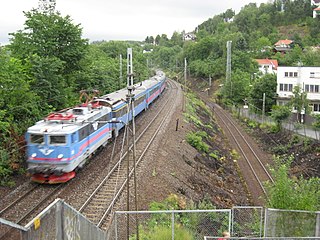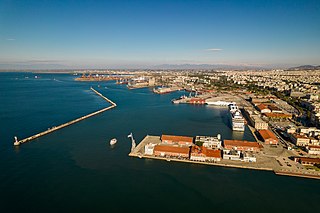Related Research Articles

Containerization is a system of intermodal freight transport using intermodal containers. Containerization, also referred as container stuffing or container loading, is the process of unitization of cargoes in exports. Containerization is the predominant form of unitization of export cargoes today, as opposed to other systems such as the barge system or palletization. The containers have standardized dimensions. They can be loaded and unloaded, stacked, transported efficiently over long distances, and transferred from one mode of transport to another—container ships, rail transport flatcars, and semi-trailer trucks—without being opened. The handling system is mechanized so that all handling is done with cranes and special forklift trucks. All containers are numbered and tracked using computerized systems.

An intermodal container, often called a shipping container, or cargo container, (or simply “container”) is a large metal crate designed and built for intermodal freight transport, meaning these containers can be used across different modes of transport – such as from ships to trains to trucks – without unloading and reloading their cargo. Intermodal containers are primarily used to store and transport materials and products efficiently and securely in the global containerized intermodal freight transport system, but smaller numbers are in regional use as well. It is like a boxcar that does not have wheels. Based on size alone, up to 95% of intermodal containers comply with ISO standards, and can officially be called ISO containers. These containers are known by many names: freight container, sea container, ocean container, container van or sea van, sea can or C can, or MILVAN, or SEAVAN. The term CONEX (Box) is a technically incorrect carry-over usage of the name of an important predecessor of the ISO containers: the much smaller steel CONEX boxes used by the U.S. Army.

Intermodal freight transport involves the transportation of freight in an intermodal container or vehicle, using multiple modes of transportation, without any handling of the freight itself when changing modes. The method reduces cargo handling, and so improves security, reduces damage and loss, and allows freight to be transported faster. Reduced costs over road trucking is the key benefit for inter-continental use. This may be offset by reduced timings for road transport over shorter distances.

American President Lines, LLC, is an American container shipping company that is a subsidiary of French shipping company CMA CGM. It operates an all-container ship fleet, including nine U.S. flagged container vessels.

The Port of Philadelphia is located on the Delaware River in Philadelphia in the U.S. state of Pennsylvania.

United States Lines was the trade name of an organization of the United States Shipping Board's (USSB) Emergency Fleet Corporation (EFC), created to operate German liners seized by the United States in 1917. The ships were owned by the USSB and all finances of the line were controlled by the EFC. Among the notable ships of this period was Leviathan, a contender for largest ship in the world for a time.

The Port of Miami, styled as PortMiami and formally known as the Dante B. Fascell Port of Miami, is a major seaport located in Biscayne Bay at the mouth of the Miami River in Miami, Florida. It is the largest passenger port in the world and one of the largest cargo ports in the United States.

Hanjin Shipping Co., Ltd. was a South Korean logistics and container transport company. Hanjin Shipping was South Korea's largest container line and one of the world's top ten container carriers in terms of capacity.

American Export-Isbrandtsen Lines, New York, was the leading US-flag shipping company between the U.S. east coast and the Mediterranean from 1919 to 1977, offering both cargo ship and passenger ship services, until it declared bankruptcy and was acquired by Farrell Lines of New York.

Malcom Purcell McLean was an American businessman who invented the modern intermodal shipping container, which revolutionized transport and international trade in the second half of the twentieth century. Containerization led to a significant reduction in the cost of freight transportation by eliminating the need for repeated handling of individual pieces of cargo, and also improved reliability, reduced cargo theft, and cut inventory costs by shortening transit time. Containerization is a major driver of globalization.

The Port of New York and New Jersey is the port district of the New York-Newark metropolitan area, encompassing the region within approximately a 25-mile (40 km) radius of the Statue of Liberty National Monument.

Drayage is the transportation of shipping containers by truck to its final destination. Drayage is often part of a longer overall move, such as from a ship to a warehouse. Some research defines it specifically as "a truck pickup from or delivery to a seaport, border point, inland port, or intermodal terminal with both the trip origin and destination in the same urban area". Port drayage is the term used when describing short hauls from ports and other areas to nearby locations. It can also refer to the movement of goods within large buildings such as convention centers. Drayage is a key aspect of the transfer of shipments to and from other means of transportation. The term drayage is also used for the fee paid for such services.

Seatrain Lines, officially the Over-Seas Shipping Company, was a shipping and transportation company conducting operations in the Americas and trans-Pacific regions. Seatrain Lines began intermodal freight transport in December 1928 by transporting entire loaded railroad freight cars between the United States and Cuba. The specially designed ship Seatrain, built in England, was followed in 1932 by two larger ships built in the United States and in 1939 by two additional ships. By the outbreak of World War II the company was operating five ships that became important in the war effort and basis for the design of fifty new ships for military use. A series of business setbacks amid the rise of containerized shipping left the company in perilous financial condition in the 1970s. Seatrain Lines shut down in 1981 after filing for bankruptcy.

The Loenga–Alnabru Line is a 7.3-kilometer (4.5 mi) freight-only railway line in Oslo, Norway. It runs from the classification yard at Loenga(Norway) to Alnabru Freight Terminal, typically serving twenty trains per day. It allows trains to pass from the Østfold Line to Alnabru without passing via Oslo Central Station. It is also used by freight trains from the Sørlandet Line, which run via the Oslo Tunnel and cross over at Bryn Station. It is notorious for the steep hill Brynsbakken which it has to climb, giving it a gradient of 2.6 percent.
The Virginia Port Authority (VPA) is an autonomous agency of the Commonwealth of Virginia that owns The Port of Virginia, a group of facilities with their activity centered on the harbor of Hampton Roads, Virginia.

The Port of Thessaloniki is the main maritime gateway to Southeast, Central and Eastern Europe, strategically located in Northern Greece close to the major Trans-European motorway and railway networks with direct access to the Southeastern European countries. ThPA S.A., listed on the Athens Stock Exchange since 2001, handles containers, conventional cargo, operates the free zone of the Port in accordance with tax and customs legislation currently in force authorized with AEO License, offers reliable and efficient logistics solutions and intermodal rail services and serves passenger traffic through cruise and ferry.

From the start of railroading in America through the first half of the 20th century, New York City and Long Island were major areas for rail freight transportation. However, their relative isolation from the mainland United States has always posed problems for rail traffic. Numerous factors over the late 20th century have caused further declines in freight rail traffic. Efforts to reverse this trend are ongoing, but have been met with limited success.

The Port of Salem is a shallow-draft port in the vicinity of the Salem River Cut-Off on the Salem River in Salem, New Jersey in the United States about 2 miles (3.2 km) east of the Delaware River and about 54 miles (87 km) from the Atlantic Ocean. It was re-designated a port of entry in 1984 and became a foreign trade zone (FTZ) in 1987. Transloading operations include the handling of a variety of bulk cargo, notably of construction aggregate, break bulk cargo, and containers for clothing, fishing apparel, agricultural produce, and other consumer goods, and has at times involved lighterage. It is operated under the auspices of the South Jersey Port Corporation. The port is envisioned as being a component of the supply chain for the development of windpower in the Atlantic Ocean off the coast of New Jersey.

ExpressRail is a network of on- or near-dock rail yards supporting intermodal freight transport at the major container terminals of the Port of New York and New Jersey. The development of dockside trackage and rail yards for transloading has been overseen by the Port Authority of New York and New Jersey, which works in partnership with other public and private stakeholders. As of 2019, four ExpressRail facilities were in operation, with a total built capacity of 1.5 million lifts.

COSCO SHIPPING Lines Co., Ltd. is a Chinese international container transportation and shipping company. It is a subsidiary of COSCO Shipping Holdings, and its parent company is China's state-owned COSCO Shipping.
References
- ↑ "Waving goodbye to the FastShip". philly-archives. 27 March 2012. Archived from the original on December 31, 2015. Retrieved 25 January 2016.
- ↑ Giles, David L. (1992). "Monohull fast sealift or semi-planing monohull ship" . Retrieved 25 January 2016.
- ↑ Giles, David L. (1992). "Monohull fast ship" . Retrieved 25 January 2016.
- ↑ "FASTSHIP ATLANTIC, INC. :: OpenCorporates". opencorporates.com. Retrieved 25 January 2016.
- ↑ "Fastship Promises To Be Next Wave In Shipping Industry". tribunedigital-baltimoresun. 2 July 1995. Retrieved 25 January 2016.
- ↑ "FASTSHIP, INC. :: OpenCorporates". opencorporates.com. Retrieved 25 January 2016.
- ↑ "Scientific American: Article: Faster Ships for the Future: October 1997". 3 March 2000. Archived from the original on March 3, 2000. Retrieved 25 January 2016.
- ↑ "Streamlined, elegant, speedy ... cargo ships". The Independent. Retrieved 25 January 2016.
- ↑ "How to shrink the world". The Economist. Retrieved 25 January 2016.
- ↑ "FastShip bankruptcy hits DRPA, rich investors". Philly.com. Retrieved 25 January 2016.